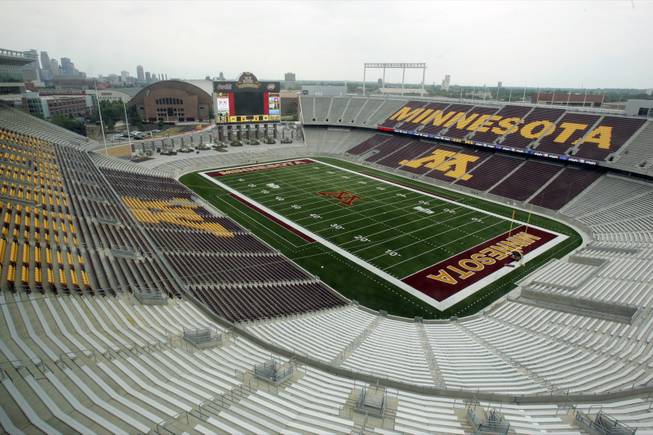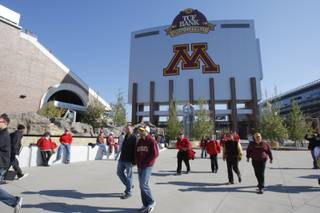
Jim Mone / AP
The Minneapolis skyline is visible in the left background Tuesday, June 16, 2009 as Minnesota Associated Press sports editors, writers and broadcasters toured the new on-campus TCF Bank Stadium in Minneapolis where the Golden Gophers will play the first football game there Sept. 12 against Air Force.
Sunday, July 15, 2012 | 2 a.m.
For 25 years, students at the University of Minnesota boarded shuttle buses on football game days and rode 15 minutes off campus to watch the Golden Gophers play at the Metrodome in downtown Minneapolis.
Much like at UNLV, the game-day environment on campus was nearly non-existent at Minnesota, but that changed in 2009 with the opening of the $300 million, 50,000-seat TCF Bank Stadium.
“It’s a completely different scene. Before, being five or six miles away from campus, you couldn’t tell that much of a difference between a game day and a nongame day,” said Garry Bowman, spokesman for Minnesota’s athletics department.
TCF Bank Stadium is the largest on-campus stadium built in the past decade. But it’s not the only one. A number of smaller schools — such as the University of North Texas, which opened an $80 million, 30,000-seat stadium in 2011 — have constructed facilities.
Minnesota’s horseshoe-shaped stadium fits in with a burgeoning district on the northeastern edge of the Minneapolis campus, which is also home to a series of biomedical research buildings.
Jan Morlock, the University of Minnesota’s director of community relations, said the stadium has played a part in jump-starting economic development on the edge of the campus, where apartments and restaurants are being built.
“Having the football stadium back on campus has been a real game-changer,” she said. “I think there is a whole lot more vigor in terms of foot traffic, in terms of commercial potential there.”
The university used a combination of state funding, private donations and student fees to pay for the stadium, and it leveraged its stadium fundraising campaign to raise millions for academic scholarships, Morlock said.
Bringing football to campus can be costly — UNLV’s proposed football stadium is estimated to cost about $500 million — but the University of Central Florida managed to keep costs down through innovative construction methods when it built Bright House Networks Stadium for $65 million.
After decades playing in the Citrus Bowl in downtown Orlando, Central Florida opened the 45,000-seat stadium in 2007 and has since seen increased engagement from students and alumni, said Bill Merck, the school’s vice president for administration and finance.
The stadium is being paid for through a naming-rights deal, private donations and revenue from football games, Merck said. The school managed to keep the price down by using a steel girder structure to build the stadium instead of more traditional building materials.
“When we were playing in the Citrus Bowl, every game was somewhat like an away game,” he said. “The new stadium has brought a lot of alumni and people from around town onto campus who typically wouldn’t come here.”



Join the Discussion:
Check this out for a full explanation of our conversion to the LiveFyre commenting system and instructions on how to sign up for an account.
Full comments policy